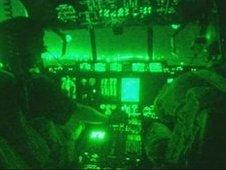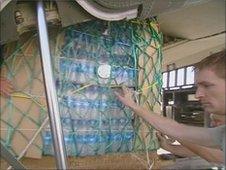Afghanistan air drops provide life support to troops
- Published
With the roads in southern Afghanistan fraught with danger for land convoys, some vital supplies are now being air-dropped into the coalition troops' more remote forward operating bases by the RAF.
The airfield at Kandahar airbase works night and day, seven days a week, transporting troops and equipment into this landlocked country.
In the blazing afternoon sun, a heat-haze rises from the tarmac as soldiers from 47 Air Despatch Squadron load up huge pallets of water and rations into the back of a Hercules C-130 aircraft.
It is a method dating back to the air drops of World War II, when British troops operating in France were re-supplied by air.
Today, air drops are being used for the smaller Nato patrol bases and checkpoints scattered across Helmand province - still one of the most hostile areas of Afghanistan.
'Life support'
Sqn Ldr Andy Wood, the officer commanding the Hercules detachment in Kandahar, said: "We do it when a convoy is having problems getting to the patrol bases because of the IED (improvised explosive device, external) threat, or if there is a high threat to helicopters or they are too busy, and we have the ability to drop stores, water, rations and ammunition."
"The despatch system has been around for a long time, going back to the Dakota, external times in the Second World War and it's a bit of a mixture between science and Heath Robinson, external.
But it works, and it's accurate and it delivers the goods that the guys really need."
The aircraft can drop loads of up to 16 tons, offering life support to forces on the ground.

The pilots have to be focused as they fly over hostile territory
But the supplies must be loaded with precision so that the weight is evenly distributed, and the parachutes on top of each pallet can open without hindrance when the moment comes.
Mistakes can be lethal, whether for civilians below or for the troops who collect the supplies. The dropping of Nato leaflets was suspended after a carton dropped by air killed an Afghan civilian, external below a few months ago.
Once darkness has fallen, the Hercules takes off for its flight over hostile territory.
The pilots are focused on their mission, but seem relaxed as the plane flies over Helmand, most of the land below us dark, apart from the few spots of light visible from the bigger towns.
Parachutes
Above us, an RAF Tornado fighter jet is flying in armed "overwatch", to ensure the Hercules is safe, while in the back of the plane the load-master and air despatchers prepare for the drop with split-second timing.
When it nears the drop zone, the Hercules banks sharply upwards to allow gravity to help shift the heavy load.
When the plane is over the right spot a green light comes on and the load is unleashed. The pallets drop rapidly out of the back, their parachutes flying open as they descend.

The supplies sent across to the troops on the ground include vital rations
It is a textbook drop.
Hercules pilot Sqn Ldr Al Whinton said: "It's a pretty good feeling to be able to resupply these guys as sometimes they're out in the field hanging on their bootlegs almost, hanging on for rations."
"We have the ability to resupply them, so they get what they need and we are pleased to do that."
On the ground, still under cover of darkness, the troops pick up these vital rations.
Patrolling and fighting in the 45-50C (113-122F) heat of a Helmand summer, the pallets of water will soon be finished, but for now the water and rations should be enough to keep the soldiers on this part of the front line going until it's time for the next re-supply from the skies.